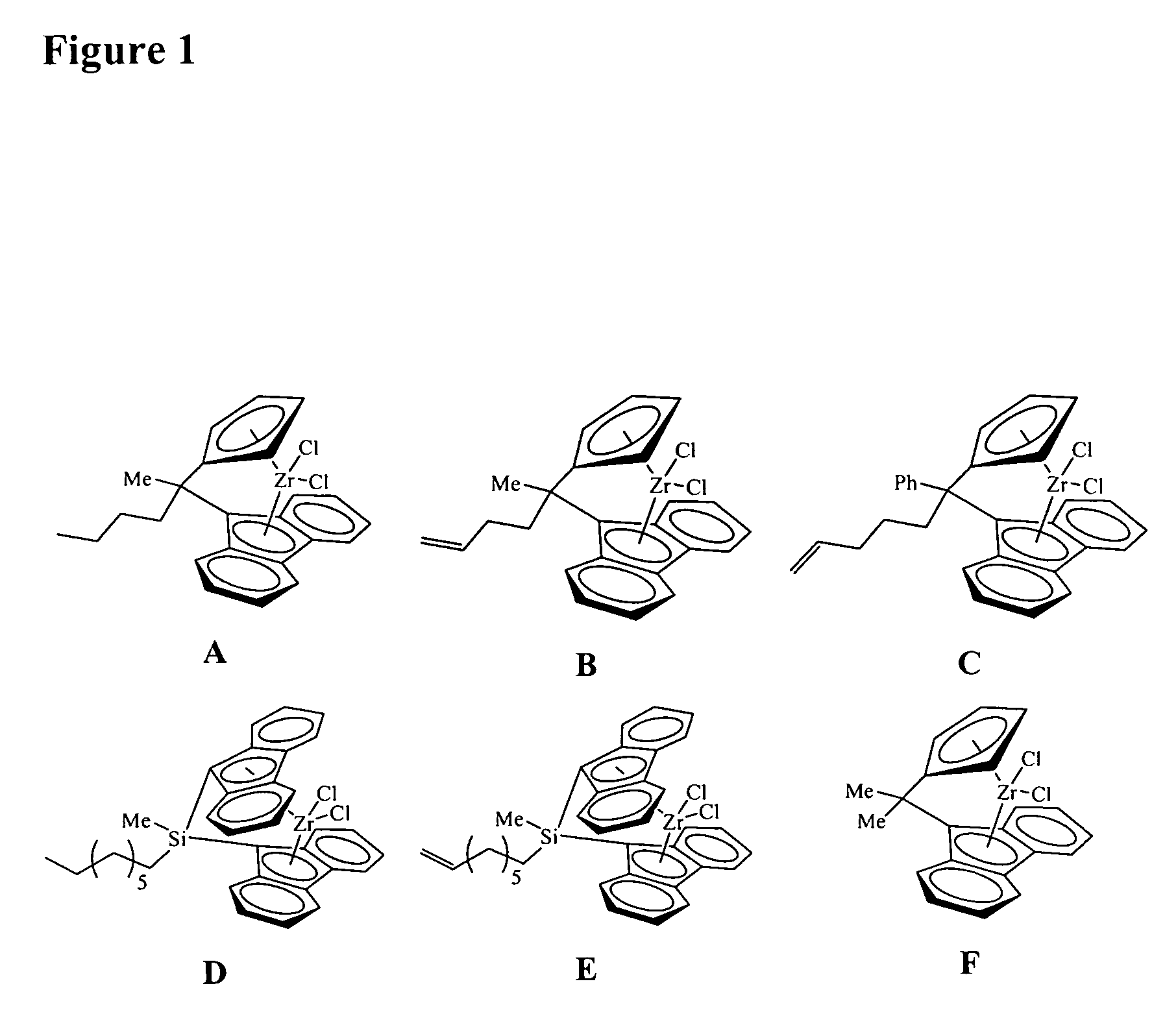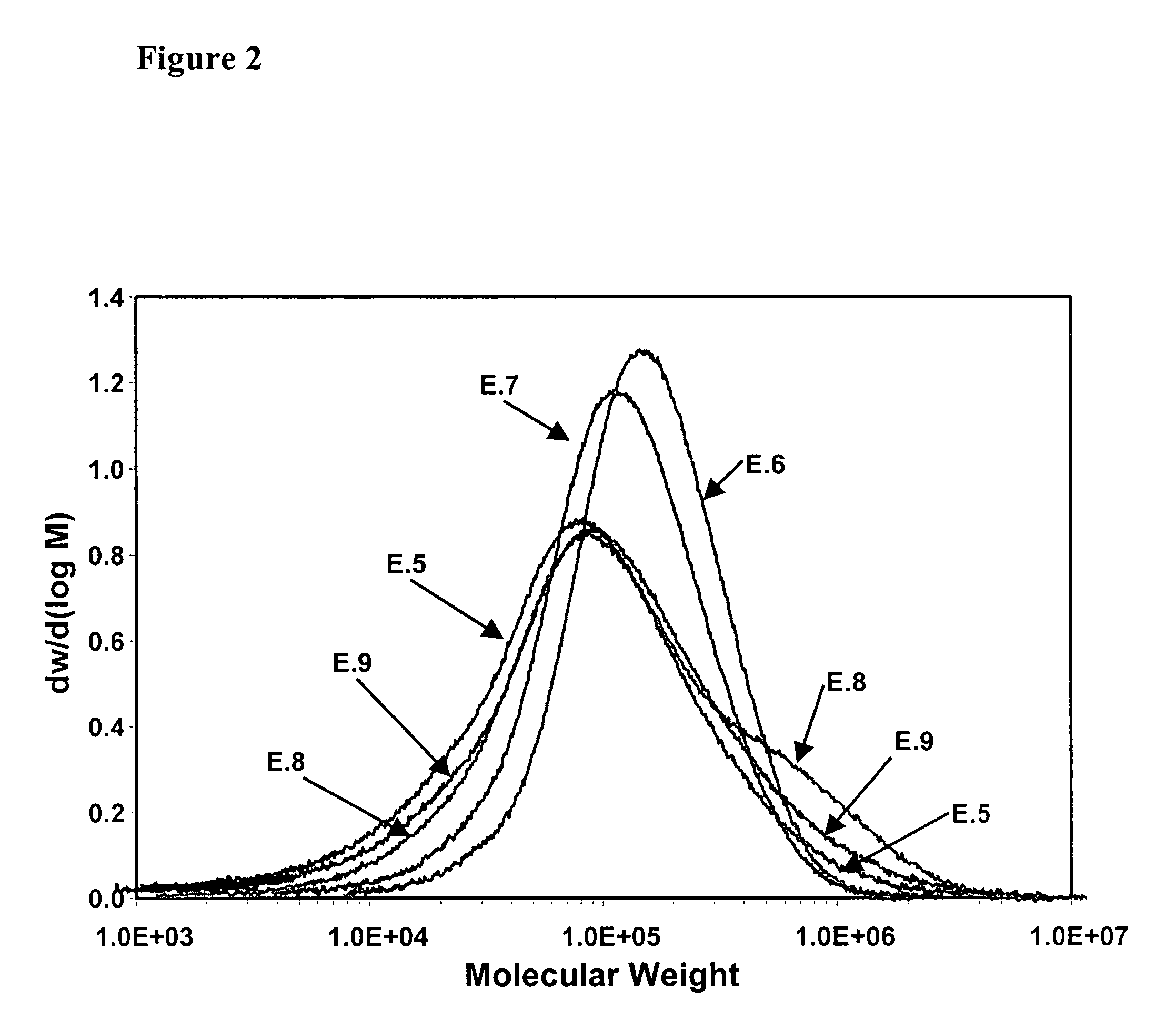Polymerization catalysts for producing polymers with low levels of long chain branching
- Summary
- Abstract
- Description
- Claims
- Application Information
AI Technical Summary
Benefits of technology
Problems solved by technology
Method used
Image
Examples
example 1
General Testing Procedures
[0266] Melt index (MI, g / 10 min) was determined in accordance with ASTM D1238 condition F at 190° C. with a 2,160 gram weight.
[0267] High load melt index (HLMI, g / 10 min) was determined in accordance with ASTM D1238 condition E at 190° C. with a 21,600 gram weight.
[0268] Polymer density was determined in grams per cubic centimeter (g / cc) on a compression molded sample, cooled at about 15° C. per hour, and conditioned for about 40 hours at room temperature in accordance with ASTM D1505 and ASTM D1928, procedure C.
[0269] Molecular weight and molecular weight distributions were obtained using a PL-GPC 220 (Polymer Labs, UK) system equipped with a differential refractive index detector and three 7.5 mm×300 mm 20 um Mixed A-LS columns (Polymer Labs) running at 145° C. The flow rate of the mobile phase, 1,2,4-trichlorobenzene (TCB) containing 0.5 g / L 2,6-di-t-butyl-4-methylphenol (BHT), was set at 1 mL / min and the concentration of polymer solutions was genera...
example 2
Preparation of a Fluorided Silica-Alumina Activator-Support
[0286] The silica-alumina used to prepare the fluorided silica-alumina acidic activator-support in this Example was typically Davison silica-alumina obtained from W.R. Grace as Grade MS13-110, containing 13% alumina, having a pore volume of about 1.2 cc / g and a surface area of about 400 m2 / g. This material was fluorided by impregnation to incipient wetness with a solution containing ammonium bifluoride in an amount sufficient to equal 10 wt % of the weight of the silica-alumina. This impregnated material was then dried in a vacuum oven for 8 hours at 100° C. The thus-fluorided silica-alumina samples were then calcined as follows. About 10 grams of the alumina were placed in a 1.75-inch quartz tube fitted with a sintered quartz disk at the bottom. While the silica was supported on the disk, dry air was blown up through the disk at the linear rate of about 1.6 to 1.8 standard cubic feet per hour. An electric furnace around th...
example 3
Preparation of a Sulfated Alumina Activator-Support
[0287] Generally, sulfated alumina was formed by a process wherein alumina was chemically-treated with a sulfate or bisulfate source, typically selected from, but not limited to, sulfuric acid, ammonium sulfate, or ammonium bisulfate. One example follows.
[0288] A commercial alumina sold as W.R. Grace Alumina A was sulfated by impregnation with an aqueous solution containing about 15-20% (NH4)2SO4 or H2SO4. This sulfated alumina was calcined at 550° C. in air (240° C. / h ramp rate), with a 3 h hold period at this temperature. Afterward, the alumina was collected and stored under dry nitrogen, and was used without exposure to the atmosphere.
PUM
| Property | Measurement | Unit |
|---|---|---|
| Fraction | aaaaa | aaaaa |
| Time | aaaaa | aaaaa |
| Percent by mass | aaaaa | aaaaa |
Abstract
Description
Claims
Application Information
 Login to View More
Login to View More - R&D
- Intellectual Property
- Life Sciences
- Materials
- Tech Scout
- Unparalleled Data Quality
- Higher Quality Content
- 60% Fewer Hallucinations
Browse by: Latest US Patents, China's latest patents, Technical Efficacy Thesaurus, Application Domain, Technology Topic, Popular Technical Reports.
© 2025 PatSnap. All rights reserved.Legal|Privacy policy|Modern Slavery Act Transparency Statement|Sitemap|About US| Contact US: help@patsnap.com



